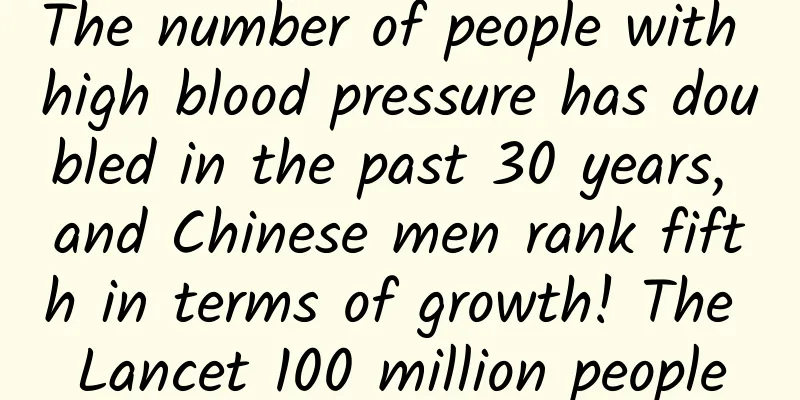The number of people with high blood pressure has doubled in the past 30 years, and Chinese men rank fifth in terms of growth! The Lancet 100 million people

|
On August 24, a study published in The Lancet covering 104 million people in 184 countries and regions around the world showed that in the 30 years from 1990 to 2019, the number of hypertensive patients aged 30 to 79 worldwide almost doubled from 650 million to 1.28 billion, of which 580 million people (45%) did not know that they had high blood pressure, and 720 million people (56%) were not treated. In 2019, the prevalence of hypertension among Chinese women was 24%, ranking ninth among the top ten countries with the lowest prevalence in the world. From 1990 to 2019, the prevalence of hypertension among Chinese men increased by 10%, ranking fifth in the world. The analysis shows that in the past 30 years, the number of women aged 30 to 79 with hypertension has increased from 331 million to 626 million, and the number of men with hypertension has increased from 317 million to 652 million, with most of the growth occurring in low- and middle-income countries. In 2019, more than 1 billion people with hypertension (accounting for 82% of the total number of people with hypertension worldwide) lived in low- and middle-income countries. 41% of female and 51% of male hypertensive patients are unaware that they have high blood pressure; 53% of female and 62% of male patients have not received treatment; less than 1/4 (23%) of female and less than 1/5 (18%) of male hypertensive patients have their blood pressure under control. Researchers found that the overall prevalence of hypertension worldwide has not changed much from 1990 to 2019, but the disease burden has shifted from wealthy countries to low- and middle-income countries. The prevalence of hypertension has declined in wealthy countries, while it has shown an upward trend in many low- or middle-income countries. In 2019, the prevalence of hypertension was lowest in Canada, Peru and Switzerland, while the prevalence of hypertension among women in Paraguay, Tuvalu and Dominica was ≥50%, and the prevalence of hypertension among men in ten countries including Paraguay, Hungary, Poland, Argentina, Lithuania, Romania, Belarus, Croatia, Tajikistan and Serbia was ≥50%. The highest treatment rates for female hypertensive patients were found in South Korea, Costa Rica, Kazakhstan, and the United States, at 73% to 77%, while the highest treatment rates for male hypertensive patients were found in Canada, Iceland, South Korea, and the United States, at 66% to 76%. The researchers analyzed 1,201 studies covering 104 million people in 184 countries or regions. These data cover 99% of the world's population and most comprehensively reflect the global trend of hypertension to date. In this study, hypertension was defined as: systolic blood pressure ≥140 mmHg, diastolic blood pressure ≥90 mmHg, or taking antihypertensive medication. Source: China Circulation Magazine |
<<: Rhinitis patient: This nose is no longer mine
Recommend
How to deal with vaginal swelling in six months of pregnancy
If swelling of the vagina occurs during the sixth...
Symptoms of a twin pregnancy
Married women usually become pregnant and give bi...
What causes breast pain after menstruation?
After my period, I sometimes feel a little pain i...
What are the taboos for ovarian cysts?
We are all very familiar with ovarian cysts. Afte...
What are the items to be checked during a female physical examination?
It is very important for women to have regular ph...
How to get pregnant quickly
Preparing for pregnancy is not a simple technical...
What does a left ovarian cystic mass mean?
Left ovarian cystic mass is a relatively common o...
Is it normal to urinate frequently during early pregnancy?
When a woman gets pregnant after marriage, she wi...
Are avocados really that magical?
In recent years, avocado has gradually become a n...
How to deal with vaginal bleeding?
Generally, women are shy when they encounter vagi...
If a pregnant woman eats mangoes, will the fetus suffer from jaundice? Benefits and precautions of eating mango for pregnant women
In order to prevent the fetus from suffering from...
Quick treatment of nipple root fissure
Many women have certain health problems with thei...
How much does it cost to have a baby?
Pregnancy is never just a matter for the pregnant...
Can I eat mussels during my period?
Mussels are a type of sea clams, and we often cal...
If a woman has these characteristics, it means she has cheated
Many women enter into marriages and families with...









